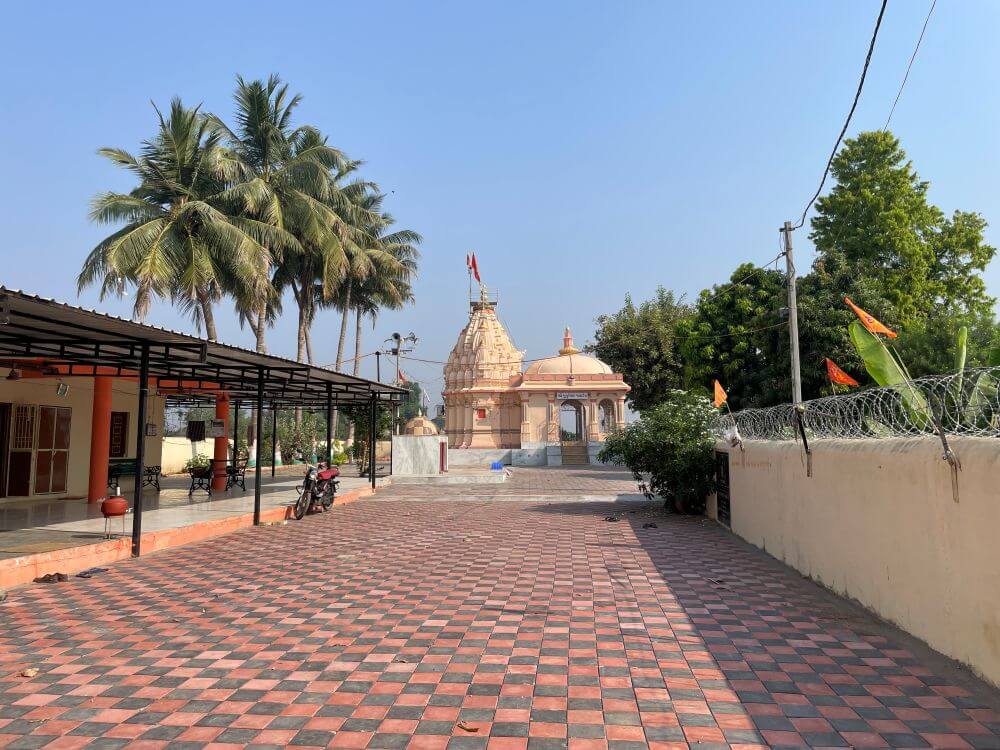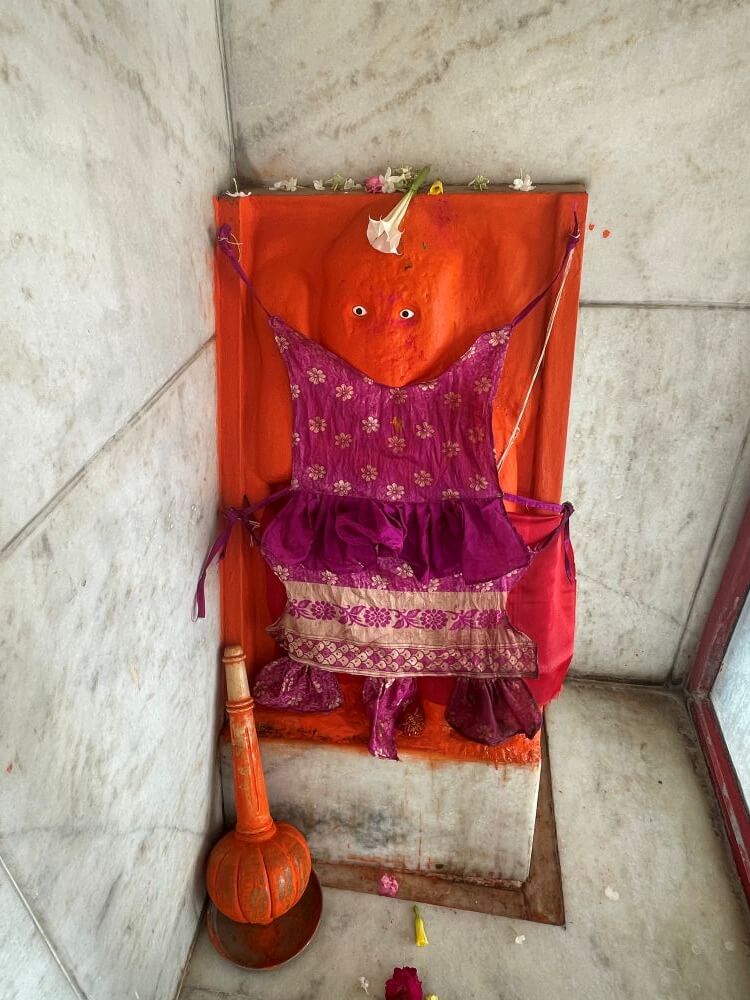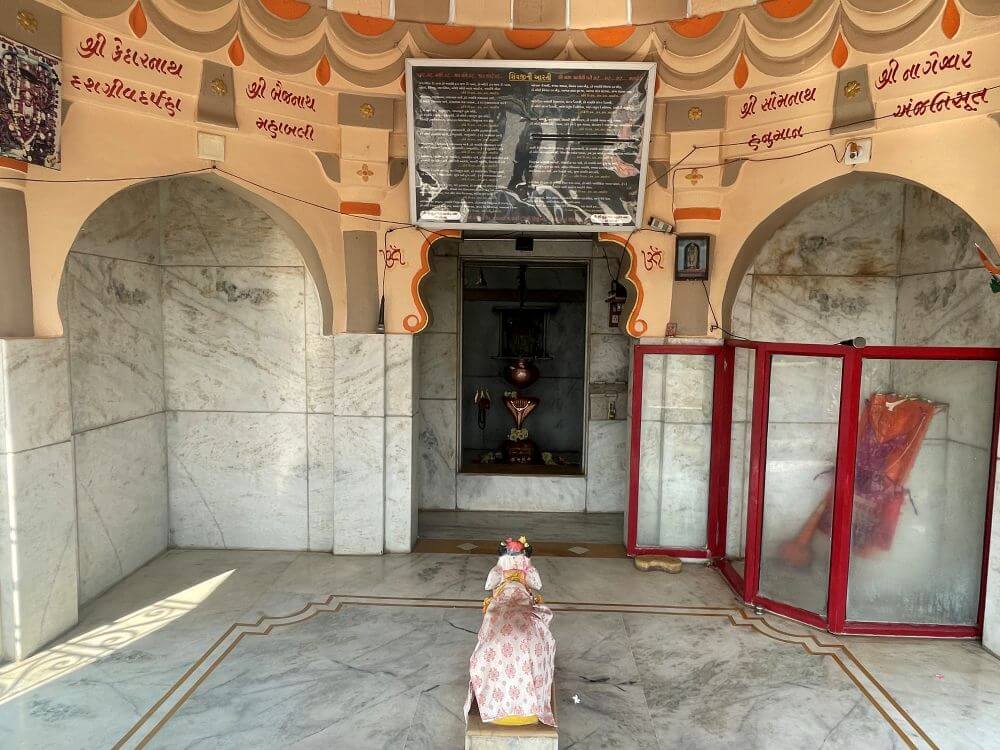
The Mukuteshwar Mahadev Temple, one of the ancient temples along the Narmada Parikrama route, is located in Sisodra village in Narmada district. According to mythology, while performing the Tandav dance, Lord Shiv’s crown (mukut) fell to the ground and transformed into a Shivling, hence the deity here is known as Mukuteshwar Mahadev. It is also believed tht the name Sisodra for the village is derived from this divine incident involving Shiv’s head (Shir). Devotees firmly believe the Shivling here is spiritually awakened (Jagrut). Due to this deep faith, the Government of Gujarat has included the temple under the Sacred Pilgrimage Development Scheme.
The Tandav dance is associated with Shiv in his Nataraja form.  Classical texts refer to Shiv’s dancing form as Nritya Murti, Nritya Dakshinamurti or Nataraja. He is also called Natesh, Nateshwar, Natshikhamani and Narteshwar. According to Sharangadeva’s treatise Sangeet Ratnakar, the origin of Tandav is described as follows – ‘प्रयोगमुद्धतं स्मृत्वा स्वप्रयुक्तं ततो हरः। तण्डुना स्वगणाग्रण्या भरताय न्यदीदिशत्॥ लास्यमस्याग्रतः प्रीत्या पार्वत्या समदीदिशत्। बुद्ध्वाऽथ ताण्डवं तण्डोः मत्र्येभ्यो मुनयोऽवदन्॥’ (Prayogamuddhatan smrutva svaprayuktam tato harah. Tanduna svaganagranye bharataya nyadeedishat. Lasyamasyagatah preetyaa parvatyaa samadeedshat. Buddhvaatha tandavam tandoh martyebhyo munayovadan.) This means, ‘Recalling the Tandav he had performed earlier, Lord Shiv instructed Tandu Muni, who was the foremost among his ganas, to teach it to Bharat Muni. Goddess Parvati was also with them. She also performed the Lasya dance.
Classical texts refer to Shiv’s dancing form as Nritya Murti, Nritya Dakshinamurti or Nataraja. He is also called Natesh, Nateshwar, Natshikhamani and Narteshwar. According to Sharangadeva’s treatise Sangeet Ratnakar, the origin of Tandav is described as follows – ‘प्रयोगमुद्धतं स्मृत्वा स्वप्रयुक्तं ततो हरः। तण्डुना स्वगणाग्रण्या भरताय न्यदीदिशत्॥ लास्यमस्याग्रतः प्रीत्या पार्वत्या समदीदिशत्। बुद्ध्वाऽथ ताण्डवं तण्डोः मत्र्येभ्यो मुनयोऽवदन्॥’ (Prayogamuddhatan smrutva svaprayuktam tato harah. Tanduna svaganagranye bharataya nyadeedishat. Lasyamasyagatah preetyaa parvatyaa samadeedshat. Buddhvaatha tandavam tandoh martyebhyo munayovadan.) This means, ‘Recalling the Tandav he had performed earlier, Lord Shiv instructed Tandu Muni, who was the foremost among his ganas, to teach it to Bharat Muni. Goddess Parvati was also with them. She also performed the Lasya dance.  Tandu taught this dance to sages, who in turn passed it on to humankind.’
Tandu taught this dance to sages, who in turn passed it on to humankind.’
Shiv is said to have performed Tandav in both rage and joy. The Raudra Tandav (fierce Tandav) expresses grief and anger – as in the tale where Sati immolates herself, enraging Shiv, who then performs Raudra Tandav. The Ananda Tandav (joyous Tandav) symbolizes creation. It is believed that during one such joyous dance, Shiv’s crown fell in Sisodra, forming a Shivling, which was then worshipped as Mukuteshwar.
The temple stands inside a spacious courtyard with high boundary walls. Entry is through a small iron gate and the entire courtyard is paved with paver blocks. A short walk leads to two small shrines dedicated to Mata Narmada and Baliyadev.  The main temple, built in Nagar style architecture, stands on a raised platform.
The main temple, built in Nagar style architecture, stands on a raised platform.
It features a Sabhamandap (assembly hall) with entrances on three sides, a small antaral (vestibule) and a Garbhagriha (sanctum). The Sabhamandap has a dome-shaped spire, topped with a lotus-shaped kalash. The sanctum has a tall Urushringa-style shikhara, adorned with a golden amalaka and kalash. After climbing six steps, one enters the Sabhamandap. In the front right corner, there’s a vermillion-smeared stone idol of Hanuman, with a mace placed nearby. Another small Hanuman idol is housed in the vestibule.
Inside the sanctum, on a copper pedestal at ground level is the large Shivalinga of Mukuteshwar Mahadev, sheltered by a brass serpent. The copper jalahari (water receptacle) above performs continuous abhishek (ritual bathing) on the pindi. On the wall behind the Shivalinga, in a niche, is an idol of Goddess Parvati.
Around 4 km from this temple, in Kamrej village, lies the Skandeshwar Mahadev Temple, said to be established by Kartik Swami, son of Shiv. The Skanda Purana and Narmada Purana mention that Kartik Swami performed penance here, on the south bank of the Narmada River.
In the vicinity of Skandeshwar Mahadev temple is the Maunibappu Tapobhumi Ashram.  The path to the temple is through this ashram. The temple is built on an elevated plinth. This small temple consists of an assembly hall and a sanctum. The assembly hall has a domed ceiling. While other Shiv temples typically have an idol of Nandi in front of the Shivalinga in the sanctum, this temple does not have one. In the center of the temple’s sanctum is a Shivalinga on a copper pedestal. Two conches are carved on the pedestal. This ancient Shivalinga is somewhat square in shape. It is sheltered by a copper serpent and above it is a silver umbrella. In a niche on the wall behind the Shivalinga is an image of Kartikeya Swami.
The path to the temple is through this ashram. The temple is built on an elevated plinth. This small temple consists of an assembly hall and a sanctum. The assembly hall has a domed ceiling. While other Shiv temples typically have an idol of Nandi in front of the Shivalinga in the sanctum, this temple does not have one. In the center of the temple’s sanctum is a Shivalinga on a copper pedestal. Two conches are carved on the pedestal. This ancient Shivalinga is somewhat square in shape. It is sheltered by a copper serpent and above it is a silver umbrella. In a niche on the wall behind the Shivalinga is an image of Kartikeya Swami.
